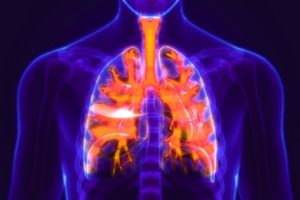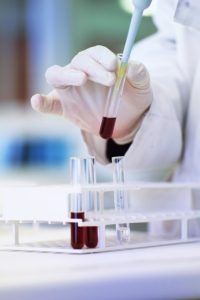Bay Biosciences provides fresh frozen clinical grade, matched high quality serum (sera), plasma and Bronchoalveolar lavage (BAL) biofluid samples from lung cancer patient’s including adeno-carcinoma and squamous cell carcinoma.
Samples are collected from unique lung cancer patients at multiple collection sites for development, drug discovery and research.
Detailed clinical data, biomarker information, serology and pathology annotations, X-ray, MRI, genetic tests data. Including Gaucher’s disease patients smoking and patients history associated with the serum (sera), plasma and PBMC biofluid samples is provided to a valued customer for research, discovery and development.

NSCLC Overview
Lung cancer is a type of cancer that starts in the lungs, Non-small cell lung cancer is a disease in which malignant (cancer) cells form in the tissues of the lung. Over 85% of lung cancer are Non-small Cell Lung cancer (NSCLC). According to the
World Health Organization (WHO) an estimated 1.8 million people people were diagnosed with lung cancer resulting in 1.6 million deaths. There are several types of non-small cell lung cancer. The main subtypes of NSCLC are adenocarcinoma, squamous cell carcinoma, and large cell carcinoma. These subtypes, which start from different types of lung cells are grouped together as NSCLC because their treatment and prognoses are often similar.
Smoking is the major risk factor for non-small cell lung cancer. Signs of non-small cell lung cancer includes shortness of breath, fever and a persistent cough that doesn’t go away.
NSCLC begins when healthy cells in the lung change and grow out of control, forming a mass called a tumor, a lesion, or a nodule. A lung tumor can begin anywhere in the lung. A tumor can be cancerous or benign. Once a cancerous lung tumor grows, it may shed cancer cells. These cells can be carried away in blood or float away in the fluid, called lymph, that surrounds lung tissue. Lymph flows through tubes called lymphatic vessels that drain into collecting stations called lymph nodes.
Lymph nodes are the small, bean-shaped organs that help fight infection. They are located in the lungs, the center of the chest, and elsewhere in the body. The natural flow of lymph out of the lungs is toward the center of the chest, which explains why lung cancer often spreads there first. When a cancer cell moves into a lymph node or to a distant part of the body through the bloodstream, it is called metastasis.
Types of NSCLC
NSCLC begins in the epithelial cells. It is important for doctors to distinguish between lung cancer that begins in the squamous cells from lung cancer that begins in other cells. This information is used to determine treatment options. Type of NSCLC is determined based on the way the cancer looks under a microscope. Following are the different types of NSCLC are:
- Adenocarcinoma
- Squamous cell carcinoma
- Large cell carcinoma
- NSCLC-NOS (not otherwise specified) or NSCLC undifferentiated
Signs and Symptoms of NSCLC
Following are the common signs and symptoms of NSCLC:
- Fatigue
- Cough
- Shortness of breath
- Chest pain, if a tumor spreads to the lining of the lung or other parts of the body near the lungs
- Loss of appetite
- Coughing up phlegm or mucus
- Coughing up blood
- Unintentional weight loss
- Hoarseness
NSCLC can spread anywhere in the body through a process called metastasis. It most commonly spreads to the lymph nodes, other parts of the lungs, bones, brain, liver, and structures near the kidneys called the adrenal glands. Metastases from NSCLC can cause:
- More problems breathing
- Bone pain
- Abdominal pain or back pain
- Headaches
- Weakness
- Seizures
- Speech difficulties
Symptoms such as fatigue, fever, pain, cough feeling sick and loss of appetite are not necessarily caused by metastases. Cancer anywhere in the body can cause a person to feel unwell in a general way. Loss of appetite can cause weight loss and muscle loss. Fatigue and weakness can further worsen a person’s ability to breathe. Muscle loss also contributes to weakness and loss of mobility. Once the cancer is diagnosed, relieving symptoms remains an important part of cancer care and treatment. This may be called palliative care or supportive care. It is often started soon after the cancer diagnosis and continued throughout treatment.
Causes of NSCLC
Exact causes of developing lung cancer are unknown. But researchers know many of the risk factors for developing lung cancers and how some of them cause cells to become cancer.
Smoking
Smoking is by far the leading cause of lung cancer. About 80% of lung cancer deaths are caused by smoking, and many others are caused by exposure to secondhand smoke. Smoking is clearly the strongest risk factor for lung cancer, but it often interacts with other factors. Smokers exposed to other known risk factors such as radon and asbestos are at an even higher risk. Not everyone who smokes gets lung cancer, so other factors like genetics probably play a role as well.
Causes in Non-smokers
Not all patients who develop lung cancer are smokers. Many people with lung cancer are former smokers, but many others never smoked at all. And it is rare for someone who has never smoked to be diagnosed with small cell lung cancer (SCLC), but it can happen. Lung cancer in non-smokers can be caused by exposure to radon, secondhand smoke, air pollution, or other factors. Workplace exposures to asbestos, diesel or exhaust or certain other chemicals can also cause lung cancers in some people who don’t smoke.
Lung cancers in non-smokers are often different from those that occur in smokers. They tend to occur in younger people and often have certain gene changes that are different from those in tumors found in smokers. In some cases, these gene changes can be used to guide treatment.
Gene changes that may lead to lung cancer
Researchers know how some of the risk factors for lung cancer can cause certain changes in the DNA of lung cells. These changes can lead to abnormal cell growth and, sometimes, cancer. DNA is the chemical in our cells that makes up our genes, which control how our cells function. DNA, which comes from both our parents, affects more than just how we look. It also can influence our risk for developing certain diseases, including some kinds of cancer.
Some genes help control when cells grow, divide to make new cells, and die:
- Genes that help cells grow, divide, or stay alive are called oncogenes.
- Genes that help control cell division or cause cells to die at the right time are called tumor suppressor genes.
Cancer can be caused by DNA changes that turn on oncogenes or turn off tumor suppressor genes. Changes in many different genes are usually needed to cause lung cancer.
Inherited gene changes
Some people inherit DNA mutations (changes) from their parents that greatly increase their risk for developing certain cancers. But inherited mutations alone are not thought to cause many lung cancers.
Still, genes do seem to play a role in some families with a history of lung cancer. For example, people who inherit certain DNA changes in a particular chromosome (chromosome 6) are more likely to develop lung cancer , even if they don’t smoke or only smoke a little.
Some people seem to inherit a reduced ability to break down or get rid of certain types of cancer-causing chemicals in the body, such as those found in tobacco smoke. This could put them at higher risk for lung cancer. Other people inherit faulty DNA repair mechanisms that make it more likely they will end up with DNA changes. People with DNA repair enzymes that don’t work normally might be especially vulnerable to cancer-causing chemicals and radiation.
Some non-small cell lung cancers (NSCLCs) make too much of the EGFR protein (which comes from an abnormal EGFR gene). This specific gene change is seen more often with adenocarcinoma of the lung in young, non-smoking, Asian women, but the excess EGFR protein has also been seen in more than 60% of metastatic NSCLCs.
Acquired gene changes
Gene changes related to lung cancer are usually acquired during life rather than inherited. Acquired mutations in lung cells often result from exposure to factors in the environment, such as cancer-causing chemicals in tobacco smoke. But some gene changes may just be random events that sometimes happen inside a cell, without having an outside cause.
Acquired changes in certain genes, such as the RB1 tumor suppressor gene, are thought to be important in the development of SCLC. Acquired changes in genes such as the p16 tumor suppressor gene and the K-RAS oncogene, are thought to be important in the development of NSCLC. Changes in the TP53 tumor suppression gene and to chromosome 3 can be seen in both NSCLC and SCLC. Not all lung cancers share the same gene changes, so there are undoubtedly changes in other genes that have not yet been found.

Bay Biosciences is a global leader in providing researchers with high quality, clinical grade, fully characterized human tissue samples, bio-specimens and human bio-fluid collections.
Samples available are cancer (tumor) tissue, cancer serum, cancer plasma cancer PBMC and human tissue samples from most other therapeutic areas and diseases.
Bay Biosciences maintains and manages its own bio-repository, human tissue bank (biobank) consisting of thousands of diseased samples (specimens) and from normal healthy donors available in all formats and types.
Our biobank procures and stores fully consented, deidentified and institutional review boards (IRB) approved human tissue samples and matched controls.
All our human tissue collections, human specimens and human bio-fluids are provided with detailed samples associated patient’s clinical data.
This critical patient’s clinical data includes information relating to their past and current disease, treatment history, lifestyle choices, biomarkers and genetic information.
Patient’s data is extremely valuable for researchers and is used to help identify new effective treatments (drug discovery & development) in oncology, other therapeutic areas and diseases.
This clinical information is critical to demonstrate their impact, monitor the safety of medicines, testing & diagnostics, and generate new knowledge about the causes of disease and illness.
Bay Biosciences banks wide variety of human tissue samples and biological samples including cryogenically preserved at – 80°C.
Including fresh frozen tissue samples, tumor tissue samples, FFPE’s, tissue slides, with matching human bio-fluids, whole blood and blood derived products such as serum, plasma and PBMC’s.
Bay Biosciences is a global leader in collecting and providing human tissue samples according to the researchers specified requirements and customized, tailor-made collection protocols.
Please contact us anytime to discuss your special research projects and customized human tissue sample requirements.
Bay Biosciences provides human tissue samples (human specimens) from diseased and normal healthy donors which includes:
- Peripheral whole-blood,
- Amniotic fluid
- Bronchoalveolar lavage fluid (BAL)
- Sputum
- Pleural effusion
- Cerebrospinal fluid (CSF)
- Serum (sera)
- Plasma
- Peripheral blood mononuclear cells (PBMC’s)
- Saliva
- Buffy coat
- Urine
- Stool samples
- Aqueous humor
- Vitreous humor
- Kidney stones (renal calculi)
- Other bodily fluids from most diseases including cancer.
We can also procure most human bio-specimens and can-do special collections and requests of human samples that are difficult to find. All our human tissue samples are procured through IRB approved clinical protocols and procedures.
In addition to the standard processing protocols Bay Biosciences can also provide human plasma, serum, PBMC bio-fluid samples using custom processing protocols, you can buy donor specific sample collections in higher volumes and specified sample aliquoting from us.
Bay Biosciences also provides human samples from normal healthy donors, volunteers, for controls and clinical research, contact us Now.
日本のお客様は、ベイバイオサイエンスジャパンBay Biosciences Japanまたはhttp://baybiosciences-jp.com/contact/までご連絡ください。
